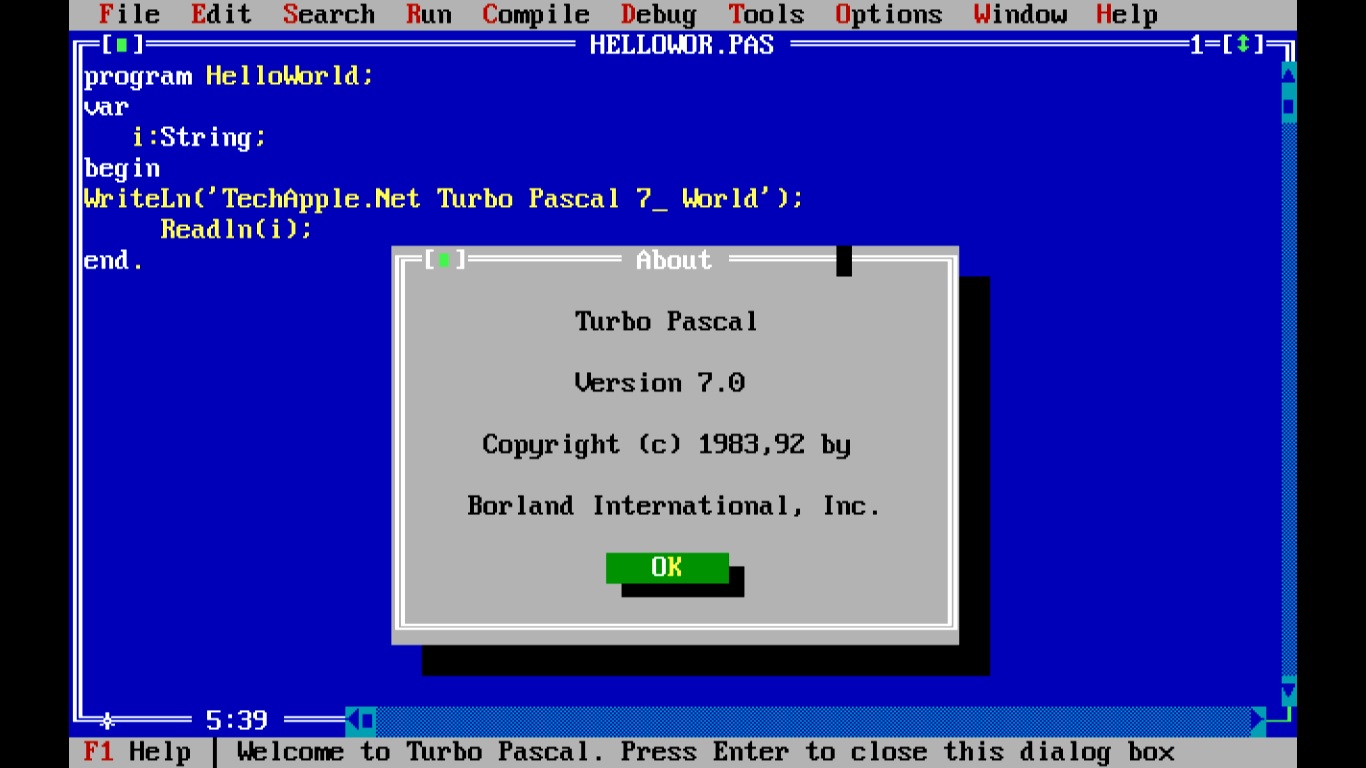Install Turbo Pascal For Windows Xp

Hi guys, today i’m gonna to show you how to install pascal on Windows 10 (10, 7, 8.1, 8 even 98,2000 and XP, also working for 32bit or 64bit) with out any installation, just extract, copy and paste. So on Windows 10, we can’t use TP normally because the issue with compatible, so we need an emulative environment – DOSBox. Now, let’s begin: Firstly, you need to download this file (.zip): Next, extract it using winrar or built-in file explorer. Then, copy “tpx folder to C: in My Computer or This PC (Windows 10, 8.1, 8). Now, open tpx folder and cut “Turbo Pascal” shortcut to your desktop.
Turbo Pascal Free Download - Turbo Pascal is the world-standard Pascal compiler. Turbo Pascal Borland Software Corporation. Windows XP, 2000, 98.
To desktop Finally, open TurboPascal on your destop and enjoy it 🙂 Bookmark my Blog to get more Tutorial of Software and Photography.
Borland Turbo Pascal: A free pre-Windows treasure How to install. The advice here was tested on an XP machine. If you have a Windows 98 (or earlier) machine that you can use, that would be fine. Maybe even better. Turbo Pascal 5.5: Long ago in the dim dark distant days before Windows, one of the most important programming environments for PCs was Borland's Turbo Pascal.
Version 5.5 of that classic is now available free, online. You can use this excellent Pascal for reasonable purposes (see the fine print if in doubt).
Being from before Windows, the download is, by today's standards, small (just under 1 megabyte. It would fit on a floppy!
Remember those?). Don't let the efficiency of the code fool you. It can do many, many things.
You can download Borland's Turbo Pascal 5.5 from: which should put the file 'tp55.zip' on your hard disc. (Elect 'Save to disc', not 'open' or 'run'.) (Borland was called 'Inprise' for a moment, and now some of their products are available from 'Codegear'. Codegear's page says it was 'created by Borland's decision to separate its developer tools group.' ) (You can get the download page directly with the link above, or go there via pages with introductions, etc, from. Down to article 'Antique Software: Turbo Pascal v5.5', click to open it.) I'm cautious: I download things to an archive area, and then work with a copy. In this case, I put the copy in C: tmp. That's not a place I normally work, but in this case there's a reason to break the rule.
You will eventually delete this, so don't worry too much. While unzipping the contents of tp55.zip, I got all tangled up, but that was just my fault. Eventually, you should have two folders, 'Disk1' and 'Disk2', in C: tmp. Neither has sub- folders.
I then went down a blind alley which I can save you exploring. Ignore whatever you may have noticed in the install instructions about keeping things in the folders created by the zip/unzip processes. Move everything from the 'Disk2' folder into the 'Disk1' folder. (There are no name duplications.) Go into 'Disk1', double-click on 'Install.exe' (which may show on your system as 'Install'.) The window that opens is rather crude. Don't be alarmed. (If you have problems doing the install, just press escape (perhaps several times) to back out.
Be advised: All of the little things we've come to take for granted in Windows are not 'givens' when you're working with an old application. For instance I couldn't use Crtl-C to copy the path the system suggested.) Also note that the sorts of things that you see during the install process, and while using Turbo Pascal, can be included in programs written with Turbo Pascal. While it didn't offer quite the ease of use of Windows, it has features that were not unlike some of the Windows interface that was yet to come, when Turbo Pascal was one of the best environments available.
Back to work. Back to how to set it up and use it on your machine. Press 'Enter' to continue past the welcome screen. Specify 'C' (probably. And if not, you should know!) as the 'Source Drive'. On my machine, the system cleverly noticed that my source path would be ' tmp disk1'. If yours does too, all well and good.
Even thought the path information seems to be 'selected', just press enter. (If your machine did not pick up the right path, and assuming you followed my advice, tell your machine that the source path is ' tmp disk1'.) Select 'Install Turbo Pascal on a Hard Drive' Now. We come to a choice. I have no doubt that the system will happily install Turbo Pascal (TP) for you where-ever you want it, i.e. In any folder. But it will be easiest to install it in a folder called TP located in the root of your C: drive. This isn't really the way we do things today, but I'd recommend that you give in to TP's expectations, just for the simple life.
Lightroom cc crack amtlib dll. That's what I've done in what follows. If you really, really don't want to do that, read the text at the bottom of the installer screen. It has some good news for you. I suspect that if you change the base folder ('directory' in the terminology of TP's day), you will need to use DOS names during the install process. After you take my advice and accept the defaults, or after you specify different folders, press F9. (There's a message to that effect in the bottom line of the installer's window.) During the install, you may get messages saying 'Cannot Execute UNPACK.COM.' I'm not sure where that comes from.